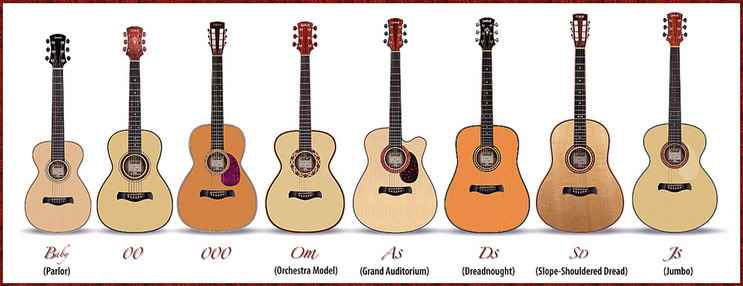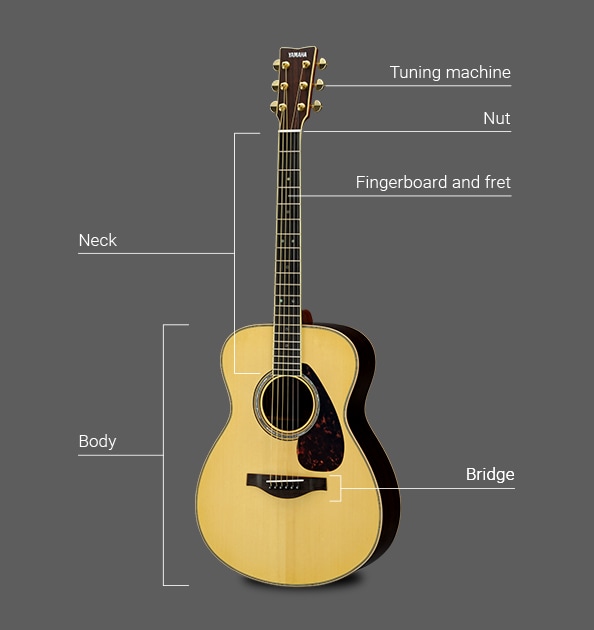Guitar Anatomy
Guitars are versatile instruments used in various musical genres, and they come in two main types: acoustic guitars and electric guitars. While their basic anatomy is similar, there are key differences in structure and function between the two. Below is a breakdown of the anatomy of both types of guitars.
Acoustic Guitar Anatomy:
An acoustic guitar produces sound naturally through the vibrations of its strings and body. It does not require electronic amplification.

Body
The body of an acoustic guitar is responsible for amplifying the sound produced by the vibrating strings.
- Top (Soundboard): Made of wood such as spruce, cedar, or mahogany. This part of the guitar amplifies the vibrations of the strings.
- Back & Sides: Typically constructed from woods like mahogany, rosewood, or maple. These materials influence the tone and resonance of the guitar.
- Bracing: Internal wooden supports that help to shape and strengthen the soundboard, further amplifying the vibrations produced by the strings.

Neck
The neck of the guitar connects the headstock to the body and houses the fretboard.
- Fretboard (Fingerboard): Usually made from rosewood or ebony. It is where the player presses down on the strings to change the pitch.
- Frets: Metal strips embedded into the fretboard that define the pitch of each note as the player presses down on the strings.
- Truss Rod: A metal rod inside the neck that allows the adjustment of the neck’s curvature, helping to maintain proper string tension.

Headstock
The headstock holds the tuning pegs and is often branded with the guitar’s logo.
- Tuning Pegs (Machine Heads): These are used to adjust the tension of the strings, which in turn tunes them to the desired pitch.
- Nut: Located at the junction of the headstock and the fretboard, the nut holds the strings in place and provides proper spacing between them.

Bridge
The bridge is located on the body of the guitar, where the strings are anchored.
- It transfers the vibrations from the strings to the body, aiding in sound production and resonance.

Electric Guitar Anatomy:
An electric guitar requires an amplifier to produce sound. It uses electromagnetic pickups to convert string vibrations into electrical signals.
Body
The body of an electric guitar is typically made from solid wood and plays a key role in shaping the guitar’s sound.
- Wood: Often constructed from woods like alder, ash, or mahogany. The choice of wood influences the tone and sustain of the guitar.
- Cutaways: These are contoured areas of the body designed to allow easier access to the higher frets.

Neck
Similar to an acoustic guitar, the neck connects the headstock to the body and houses the fretboard.
- Fretboard (Fingerboard): Usually made from rosewood, maple, or ebony. Like an acoustic guitar, this is where the player presses down the strings to alter pitch.
- Frets: Metal strips placed along the neck, which define the notes produced when the strings are pressed.
- Truss Rod: A metal rod inside the neck, used to adjust the curvature and maintain optimal playability.

Headstock
The headstock of an electric guitar holds the tuning pegs and can often be found with additional features.
- Tuning Pegs (Machine Heads): These are used to tune the guitar’s strings.
- Locking Tuners: Some electric guitars feature locking tuners that improve string stability and reduce tuning issues.

Pickups
The pickups on an electric guitar convert string vibrations into electrical signals.
- Single-Coil Pickups: These produce a bright, sharp sound and are often found on Fender guitars.
- Humbucker Pickups: These provide a thicker sound and reduce unwanted hum or noise.
- Pickguard: A plastic sheet that protects the body from scratches, particularly from the pick.

Controls
Electric guitars often feature several controls to adjust the sound.
- Volume & Tone Knobs: These control the loudness and tonal characteristics (e.g., treble and bass).
- Pickup Selector Switch: A switch that allows the player to select different pickups to modify the tone.

Bridge
The bridge anchors the strings and contributes to the guitar’s tone.
- Fixed Bridge: A bridge that remains in place and helps with stable tuning and sustain.
- Vibrato/Whammy Bar: A feature that allows the player to alter the pitch of the strings by pushing or pulling on the bar.

Similarities Between Acoustic and Electric Guitars:
- Both types of guitars feature strings, frets, and tuners.
- Both guitars have a neck, headstock, and bridge.
Differences Between Acoustic and Electric Guitars:
- Acoustic guitars produce sound naturally through the body, while electric guitars require amplification.
- Electric guitars use pickups to convert vibrations into electrical signals, whereas acoustic guitars rely on the vibrations of the strings and the body to generate sound.
Additional Notes:
- The size and shape of the body may vary depending on the style, such as a dreadnought for acoustic guitars or a solid body for electric guitars.
- The type of wood used for both the body and neck can significantly affect the guitar’s tone, resonance, and sustain.
References:
- date: 2025.01.12
- time: 18:08
This note provides an overview of the anatomy of acoustic and electric guitars.